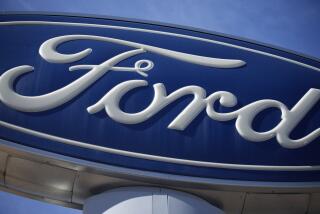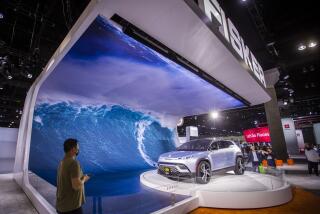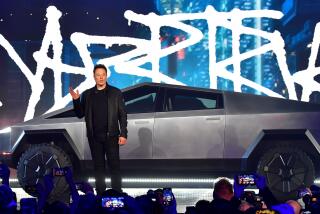Ford Looks Down a Long Road Back
- Share via
The top-selling Ford dealer in the world is adding a new line to his sales pitch: Buy Honda.
Bert Boeckmann, president of Galpin Automotive Group, has added a franchise of the highflying Japanese brand to his Saturn, Mazda and Ford businesses in the San Fernando Valley.
Fewer and fewer Americans are driving Fords lately. In a time of persistently high gasoline prices, many buyers are switching from big trucks -- long the company’s bread and butter -- to smaller cars, the weak segment in its lineup.
“You can’t increase your market share until you get product people want,” Boeckmann said of his longtime partners at Ford Motor Co. in Dearborn, Mich. The 75-year-old dealer, who sold his first Ford at Galpin in 1953, remains a true Blue Oval man. But he’s far from alone in wondering about the Ford in his future.
The automaker’s board approved a new round of worker buyouts and factory shutdowns disclosed Friday under a revised plan to staunch the sudden flow of red ink -- $1.4 billion and counting this year. The announcement came not quite eight months after the company said it would eliminate 30,000 jobs as part of a deep restructuring dubbed the Way Forward.
Joining Chairman William Clay Ford Jr. at the board table last week was the newly appointed chief executive, Alan Mulally. The manufacturing expert from Boeing Co., only the ninth CEO in the automaker’s 103-year history, has his work cut out in helping the company reconnect with both Wall Street and Main Street.
Winning back the public will be crucial. Beyond Friday’s announcement, industry analysts and insiders alike say, the automaker now needs to unleash its designers, speed product development and find a way to restore a damaged brand.
“They still have products that are a little long in the tooth at a time the market is experiencing a significant shift” to smaller cars and SUVs, said David Cole, head of the nonprofit Center for Automotive Research in Ann Arbor, Mich.
Given the years it takes to bring new metal to market, with start-up costs approaching $1 billion for a single model, the company faces a long road back to health.
“They have to deal with that, and it’s going to be pretty tricky in the midst of a restructuring,” Cole said. “Kind of like changing the fan belt while the engine’s running.”
The company said Friday that by the end of 2008, 70% of its Ford, Mercury and Lincoln vehicles would be new or significantly upgraded. But it gave little guidance about promised new small cars intended to take on the likes of Honda Motor Co.’s Fit, Toyota Motor Corp.’s Yaris and Nissan Motor Co.’s Versa.
To be sure, Ford has shown in the past that it can innovate.
The company created the so-called pony car market in 1964 with the stylish Mustang. Its mid-size Taurus was the topselling car in the early 1990s, beating back Honda’s Accord and Toyota’s Camry. Ford blew away the competition in 1990 with the Explorer SUV, which begat even larger trucks that won over both soccer moms and trailblazers. And the company built the F-150 pickup into the top-selling passenger vehicle, a title it has held since 1981.
But nowadays Ford doesn’t have many unqualified market hits outside of, well, the Mustang, which it redesigned for 2005 to look like its 1960s predecessor. The combined market share of the company’s domestic brands fell to an all-time low of 16.8% through the first eights months of the year.
Ford’s course has changed dramatically in the last several years.
At the turn of the millennium, many analysts forecast that Ford could break General Motors Corp.’s decades-long run as the top seller worldwide. But today it is Toyota, with its mix of fuel-efficient small vehicles and strategically marketed trucks, that has overtaken Ford and is pulling even with GM.
As he prepared to take the chairmanship in 1999, Bill Ford proclaimed that his company would become the most environmentally friendly major automaker. The company did roll out the first gasoline-electric hybrid SUV, the Escape. But Ford’s truck fleet’s average fuel ratings this year are the worst in the industry.
And as Ford continued to rely on its highly profitable trucks, Honda and Toyota, with their hybrids and other fuel-sipping cars, ended up taking the “green” crown and being best positioned to capitalize on the recent shift in customer preferences.
Meanwhile, Ford was hiring some of the top designers in the world. But the company suffered misses in the marketplace, notably the revived Thunderbird, compounded by what critics see as a corporate reticence to unleash its talent. Today’s style-conscious customers and auto critics laud the leading German brands as well as Chrysler Group and Nissan, two companies that have been able to design and build their way out of their own recent financial funks.
With the competition unrelenting, Ford can’t just shrink its way to health, experts say.
But cutting overhead alone won’t fix the cash crises at Ford or rival GM, said Charlie Hughes, former head of U.S. operations for Mazda and Land Rover. “They need better products and clearer branding to sell more cars.”
Hughes says in a new book he coauthored, “Branding Iron,” that by trying to manage eight brands, including Mercury, Lincoln, Land Rover, Mazda and Aston Martin, Ford is hard-pressed to make any of them stand out.
The company should cut back to selling only Fords, Volvos and Jaguars, he said, and market those brands aggressively “with a pathological focus” on improving them.
The board also needs to agree to spend cash to pep up showroom offerings, said design consultant Charles Pelly, former president of BMW’s Designworks/USA studio in Newbury Park.
“It takes courage from top management when a company is in trouble,” he said.
Instead of cutting-edge design, Ford has relied too heavily on the retro styling of cars like the revamped Mustang or the generic Asian-European look in more mass-market models, Pelly said.
To Julio Campos, whose Santa Monica marketing firm Campos Creative Works Inc. does work for many automakers, “the No. 1 issue Ford faces from a sales and marketing standpoint is the design of their products.”
“It doesn’t matter what kind of marketing campaigns and advertising they have,” he said, “when the products they are putting out there are at the very least five or 10 years behind Japanese and European cars from a design standpoint.”
One hope is the new Ford Edge crossover, due in showrooms in early November, along with an upscale Lincoln variant, the MKX.
Crossovers are built on passenger car platforms rather than pickup truck frames and offer the roominess of a traditional SUV but with sleeker styling, better fuel efficiency and more car-like ride and handling.
Early reaction to the Edge has been “very good,” said George Pipas, Ford’s in-house sales and market analyst. “The number of people hitting our website is 50% more than we had for the Fusion,” one of the few vehicles doing well for Ford.
The company’s mid-size domestic sedans -- the Fusion and its siblings, the Mercury Milan and Lincoln Zephyr -- have sold well since their introduction a year ago.
The automaker is on track to increase its share of the passenger car market again this year, after posting its first such gain in 12 years in 2005.
Ford’s Land Rover brand has been gaining sales and turning a profit this year. Likewise, its Volvo unit is profitable, although sales are down.
One thing the company has going for it is that it commands owner loyalty.
Almost 47% of buyers who traded in a vehicle from the Ford brands in the first eight months this year bought another Ford product, said Tom Libby, analyst for the Power Information Network, a J.D. Power & Associates affiliate that gathers sales data directly from dealerships. “That’s high for a domestic company,” he said.
Cynthia Cormier, manager of a telemarketing call center in Minnesota, is one of those loyalists. She recently placed an order for a 2007 Edge and is trading in a Mercury Mountaineer SUV.
She ordered the Edge, she said, “because I need SUV room but I’m tired of driving a box on wheels.”
Cormier, 48, said she looked at Toyota’s RAV4 crossover as well but preferred the Edge’s styling. “And I’ve been treated so well by my Mercury dealer that I decided to stay in the Ford family.”
But such fans are a decided minority: Only 25% of all shoppers bother to put Ford vehicles on their lists these days, said J.D. Power analyst Jeff Schuster.
Many are like Dave Nelson, finance director for a Silicon Valley telecommunications equipment firm. The 50-year-old Danville resident bought a RAV4.
“Frankly, having a Ford just doesn’t appeal to me,” said Nelson, who traded in a wagon from its upscale Volvo brand but found Ford itself to be too down-market for his tastes.
To help win over such shoppers, the automaker must counter the negative news its financial woes have engendered, analysts say.
“They need to get Mulally out in public as soon as possible to talk about things they are going to be doing,” market research specialist George Peterson said of the new CEO.
“So far, they haven’t definitively showed what this Way Forward program is all about, and publicity like they’ve been getting makes consumers think twice about buying your cars,” said Peterson, president of AutoPacific Inc. in Tustin.
Ford executive Pipas said the company foresaw the market shift from trucks and began planning in 2002 for the Fusion and its siblings, as well as for the Edge crossover.
He acknowledges, though, that Ford failed to anticipate the rapid rise in fuel prices and the extent of their effects on its pickup and SUV sales.
Pipas notes as well that the company has been slow to develop a small car to compete with the Japanese subcompacts that are hot sellers in the U.S. market.
“Guilty as charged,” he said. “Detroit just didn’t pay attention to this segment.”
Ford will indeed have a new small car for the U.S. but not for several years -- a wait that concerns many dealers.
Brian Wood, general manager of Power Ford of Tustin, said dealers would have to win over auto shoppers by “sharpening our skills, focusing on follow-up, giving our customers the best treatment possible” while waiting for Ford to turn on the vehicle development tap.
To the Galpin group’s Boeckmann, “it all comes down to product.”
And Ford just doesn’t have enough of the right stuff, especially smaller, more fuel-efficient cars, he said.
“The last three years have been tough,” said Boeckmann, who transferred four sales managers from Galpin Ford to his Honda store when it opened in July.
“And the next two are going to be critical.”
*
*
Times staff writers Martin Zimmerman and Roger Vincent contributed to this report.
*
(BEGIN TEXT OF INFOBOX)
*
Lineup of products
Ford
This year: Edge crossover debuts; Expedition large SUV is redesigned
2007: F-series Super Duty pickups are redesigned; Focus compact gets restyled; Five Hundred sedan is updated; Escape crossover SUV is redesigned
2008: F-150 pickup is redesigned; new minivan alternative is introduced; Crown Victoria full-side sedan is updated
2009: Small sedan and small crossover debuts; Mustang is restyled
Mercury
2007: Montego sedan and Mariner SUV are updated
2008: Grand Marquis large sedan is updated
Lincoln
This year: MKX crossover debuts. Navigator large SUV is redesigned
2008: MKS mid-size sedan debuts; Mark LT pickup is redesigned
Aston Martin
This year: Vantage and DB9 Volante convertible make debuts
2008: Rapide 4-door sedan debuts
Jaguar
This year: XK models is redesigned
2008: S-type is redesigned
Land Rover
2007: New entry-level LR2 replaces Freelander
Volvo
This year: C70 convertible is redesigned
2007: C30 small hatchback debuts; S80 large sedan is redesigned; XC70 wagon is redesigned
2008: XC50 crossover utility debuts, V70 wagon is redesigned
*
Source: Automotive News






